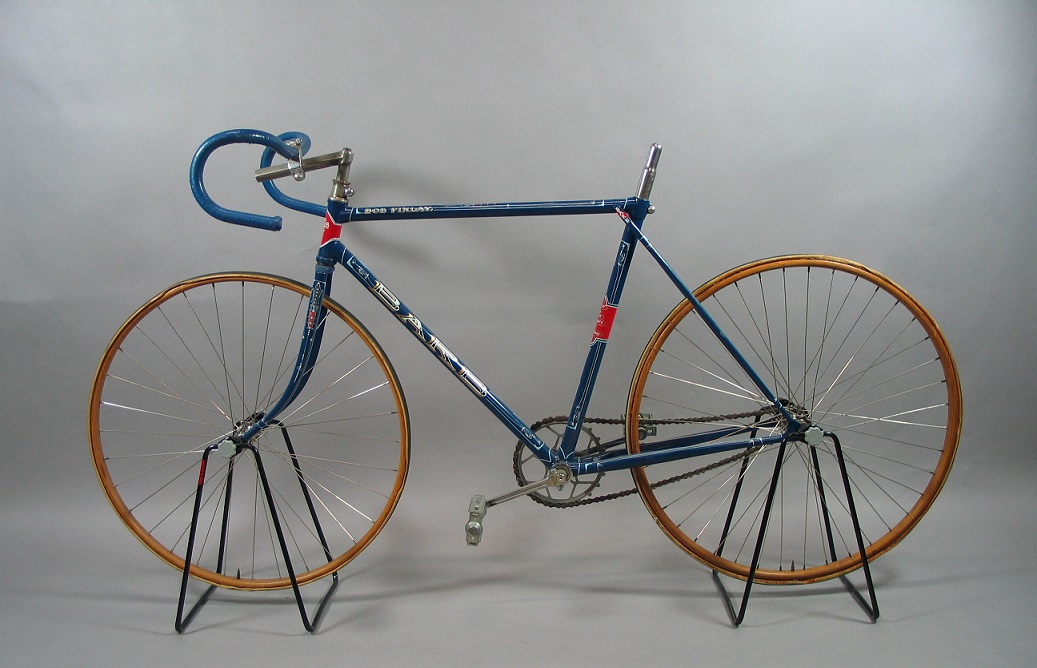
Track bicycle used by Bob Finlay. Image courtesy of the Australian Gallery of Sport and Olympic Museum (AGOS-OM) collection (1993.2931.14).
Almost 150 years ago, the original “The Barb” velocipede – ridden by James Finlay - won a race on the Melbourne Cricket Ground (M.C.G.) that is thought to have been Victoria’s earliest known bicycle race.1
The museum that now stands within the M.C.G.’s stadium - the National Sports Museum - continues the connection with Barb cycling history with its holding* of a Barb track racing bicycle of James Finlay’s son - Bob Finlay.
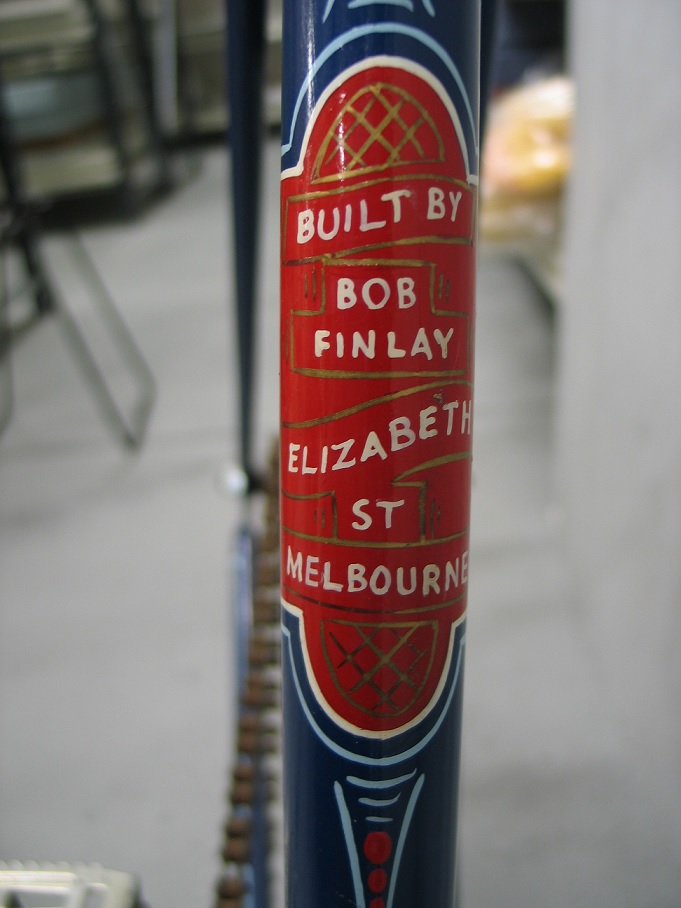
Fine lettering on the bicycle’s seat tube.
Image courtesy of the AGOS-OM collection (1993.2931.14).
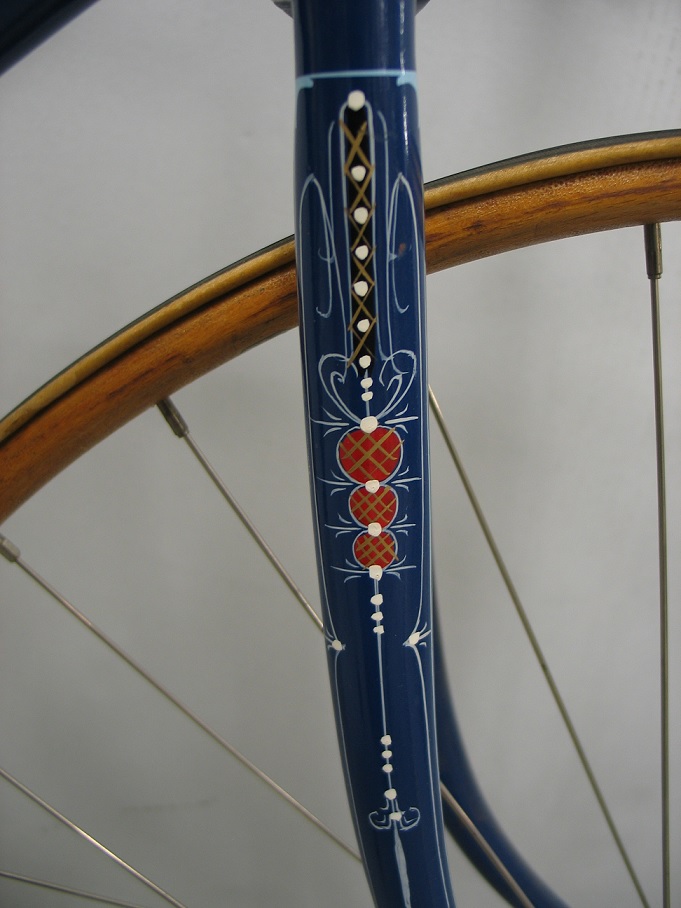
Fork fork detail.
Image courtesy of the AGOS-OM collection (1993.2931.14). |
This beautifully restored track racing Barb bicycle has had an interesting ride through life.
It is thought to have been both built and raced by Bob Finlay in the 1920’s.2 Bob Finlay was a successful early cyclist who competed in many Victorian cycle racing events, including gaining second place in the 1905 Warrnambool to Melbourne race.3 He also spent time racing motor-paced bicycles in Salt Lake City prior to World War I,4 and it is probable that his time in Salt Lake City was as a paid cyclist, thereby making him a professional competitor. By the 1920’s, Bob Finlay would have been 35 or older, and would have probably passed the peak of his competitive cycling career, so it is possible that the bike is of an even older vintage .
Bob Finlay is certainly known to have had significant input into some of the bicycle designs and constructions of the Barb bicycles that were being made by Finlay Brothers. This continued on in later years with unique pace bicycle design – for use in the sport of motorcycle paced cycling.5 Bob continued his involvement in this sport as a highly skilled and renowned motor-pace motorcyclist – pacing the likes of Hubert Opperman,6 “Fatty” Lamb7 and Ossie Nicholson.8
The track racing Barb bicycle held in the Australian Gallery of Sport and Olympic Museum (AGOS-OM) collection is one of several bicycles in a large collection of cycling memorabilia donated to the AGOS-OM collection by Rupert Bates and his wife Rita between 1985 and 1993.9 Rupert Bates, having been a very successful Victorian racing cyclist, was also remarkable in having opened his own bicycle works in his late teens, turning out “Cyclone” bicycles.10 He continued a lifelong career in the cycle industry, later using the name “Bates” for his bicycles, and running Bates Cycles and Batco Services from premises in Clifton Hill and later Coburg.11 By the 1950’s, he was employing approximately 17 men full time and 4 casuals, and making 10,000+ frames a year.12
Rupert Bates had quite an interest in old racing bicycles used by premier competitors. This was certainly well documented during a visit by the “Herald” newspaper to the Bates cycle works in 1985. The experience was later described:
“Come up here”, says Rupert Bates, interrupting himself to trot nimbly up a ladder to a loft. There hangs a rack of memories: a row of bikes used by top riders.
The old man recites a litany of once-famous names. “This was Gordon Johnson’s – he won the world sprint title; this was Ossie Nicholson’s – he won at the Olympics; this belonged to Ernie Bainbridge, who just died; this was Jimmy Coyle’s; Syd Patterson used one like this…”13
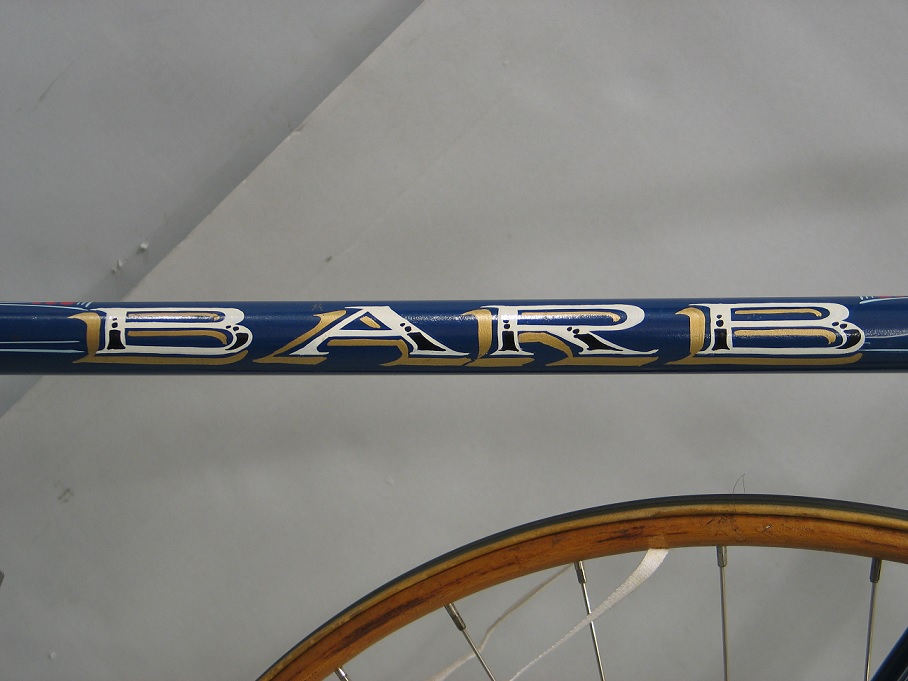
Large style of Barb lettering on the down tube.
Image courtesy of the AGOS-OM collection (1993.2931.14).
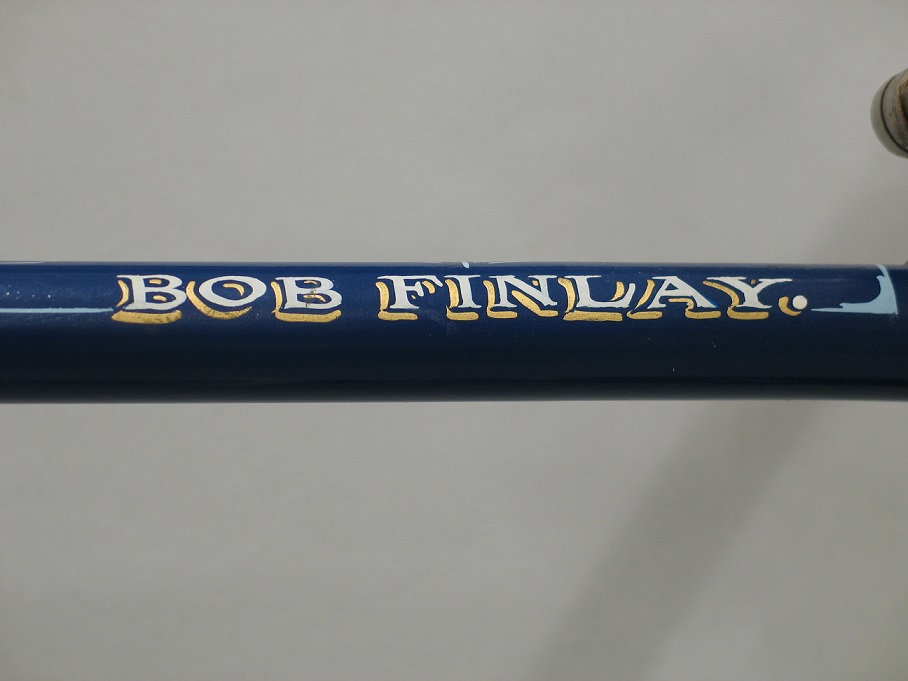
Paintwork detail on the bicycle’s top tube.
Image courtesy of the AGOS-OM collection (1993.2931.14).
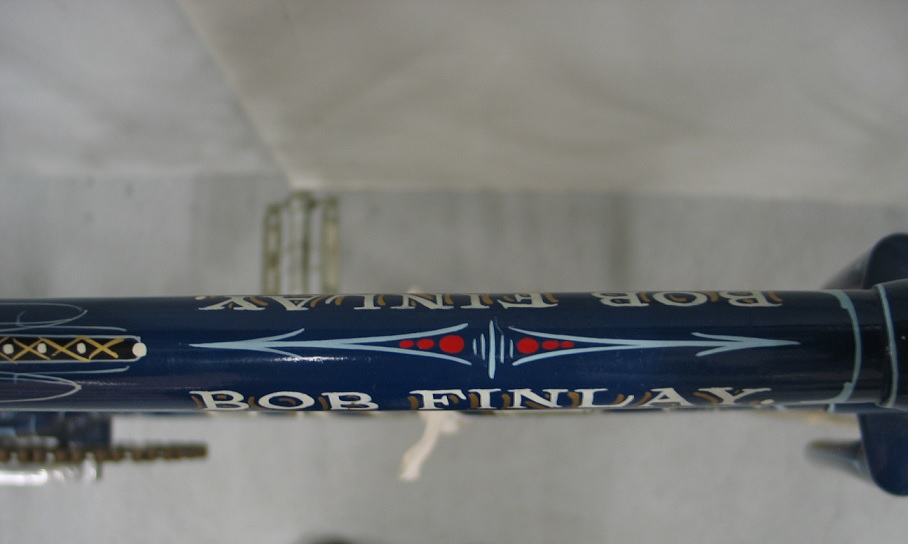
Overhead view of paintwork on the top tube.
Image courtesy of the AGOS-OM collection (1993.2931.14). |
Rupert Bates’ specialty, in the later years of his cycle business, was the making of custom-built frames for top racing cyclists.14 This seems a fitting niche for a man who maintained such a strong collection of top racing bikes from riders of the past. In fact, with his foresight in preserving these old racing bicycles, many of which were probably custom-built racing machines themselves, a tangible record of cycling history has been created.
How long Rupert Bates owned the Barb bicycle of Bob Finlay’s is unknown. However, as with many of the vintage bicycles held by Rupert Bates, the frame was restored and repainted. The name “Bob Finlay” was painted across the bicycle’s top tube. The gentleman who carried out the paintwork on this frame during the 1980’s – Kenn Dickie - recalled that such bicycles were often put on display at places such as banks.15
Kenn Dickie visited the National Sports Museum recently (April 2013) to see this Barb and several others of Rupert Bates’ bikes. Kenn recognised the paintwork details on the bicycle as being his own handiwork, thereby making a tangible link to the period of time that this bicycle was held in Rupert Bates’ collection, and its restoration.
Kenn Dickie’s involvement with Rupert Bates began in the early 1960’s, during which time he was involved in the restoration of vintage bicycles as well as the paintwork on new bicycles built by the Bates firm.16 Kenn’s recollection is that the paintwork on bicycles being restored would usually take him about 3-4 hours per bicycle, and that he would work to his own design for each bicycle.17 This would involve the actual repainting of the frame as well as the signage and pinstriping.
Kenn recalls that he did such work for Rupert Bates for 4 hours on a Tuesday and Thursday evening, and all day Saturday. Another bicycle decorator worked on Monday and Wednesday evenings as well as Saturdays,18 and the Bates family remember that Norm Bates (Rupert’s son) also assisted with the hand line work during the latter years of the business too.19
Work by Kenn on two other restored Barbs, held by private collectors, is also on display within this website.
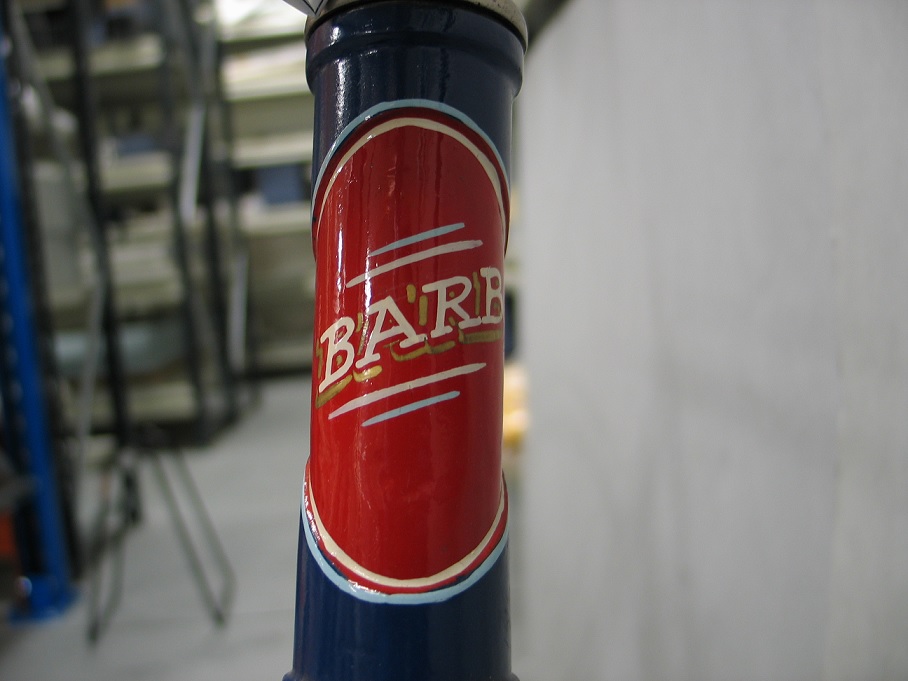
Head tube detail.
Image courtesy of the AGOS-OM collection (1993.2931.14).
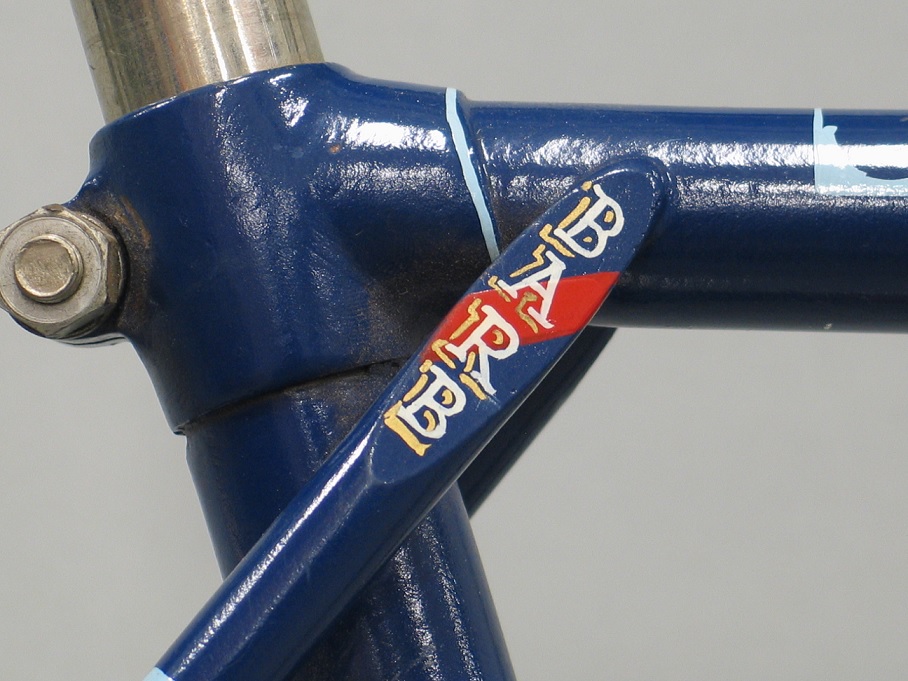
Beautiful detail on the rear seat stay.
Image courtesy of the AGOS-OM collection (1993.2931.14). | In 2005, Kenn gave a talk at the Australasian Cycling History Conference about his craft, and we are grateful to both the convenors of this conference as well as the author of the following introduction – Rod Charles – for allowing us to publish parts of an introductory speech that was given prior to Kenn’s presentation.
The following excerpts give great insight into Kenn’s amazing work.
Kenn Dickie’s connection with this bicycle provides a “living link” within the history of this Barb, allowing its life to be traced back many decades, and importantly, he was a significant part in the preservation of it, as well as many other vintage racing cycles:
Kenn Dickie – Bicycle Frame Decorator
An Introduction (by Rod Charles)
Kenn grew up in Victoria in the 1940’s. He began his working life in the Cycle Enamelling Department in 1952, at the age of 14, with General Accessories Pty Ltd in Clarendon Street, South Melbourne – in the cycle business. Their hallmark product was Malvern Star bicycles.
His first jobs were washing the paper off the gold size transfers with water then kerosene, then drying the frames and painting or filling in the stars on the head and forks.
He very quickly moved to doing the most exacting line work. After 6 months or so after starting, a liner resigned and Kenn took his position, lining and writing names “as best I could” he says. “The lining took a fair bit of practice at home” he says, and he studied sign writing from sign and lettering books. He was very self-motivated, very interested. He generated his own learning.
He became apprenticed and was signed on with the firm in 1953.
His training included a four year course in signwriting at RMIT.
In the enamelling department jobs were clearly defined, and in some cases jealously guarded. The enthusiastic young apprentice set high standards of workmanship. Rims, mudguards and chainguards were all lined by hand, as well as frames and forks, which also had scrollwork applied. Track racing frames and frames for the Malvern Star racing team members all received special attention, as did frames used in special races such as the tandem used by Ian Brown and Tony Marchant in the Melbourne Olympic Games. Between 80 and 100 frames were enamelled each day.
For the next ten years at General Accessories he did lining, scrolling, spray painting, lining motor bike side-cars and auto-bikes, as well as general signwriting around the factory. He also wrote “idiot boards” for commercials to be screened on television.
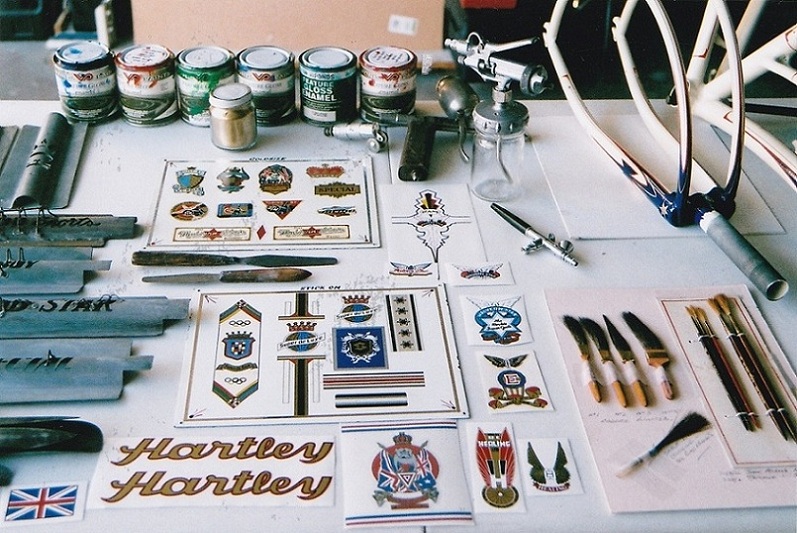
Paints and transfers as used in cycle trade plus brushes, etc.
Photograph by Kenn Dickie.
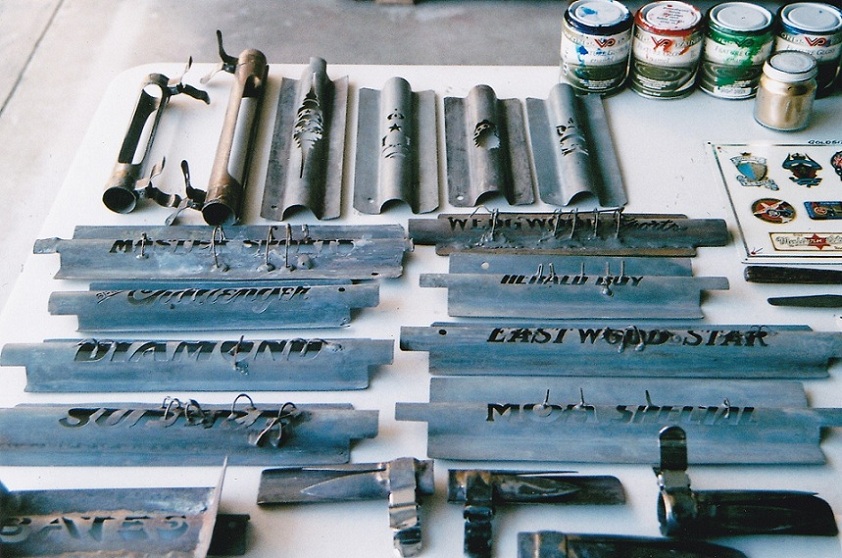
Metal stencil names – these were attached to main bar or seat bar and names spray
painted. Names were then edge lined or shaded as required.
Photograph by Kenn Dickie.
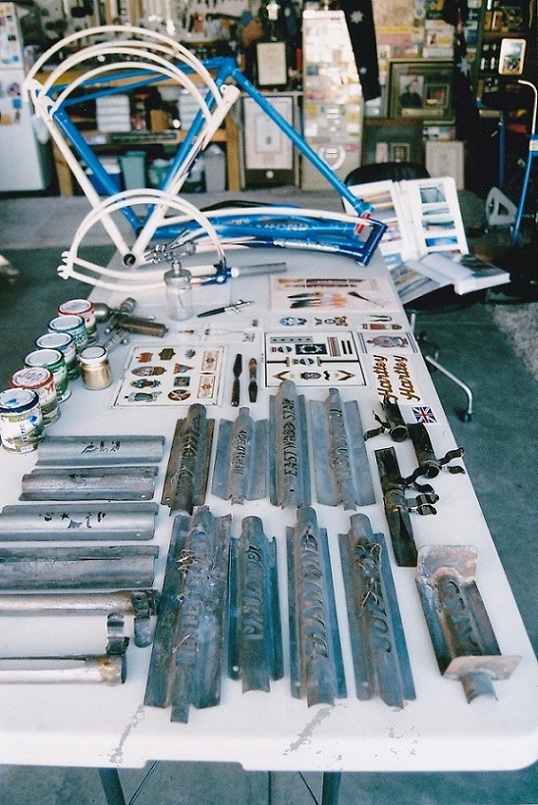
A view of Kenn Dickie’s tools and workshop.
Photograph by Kenn Dickie.
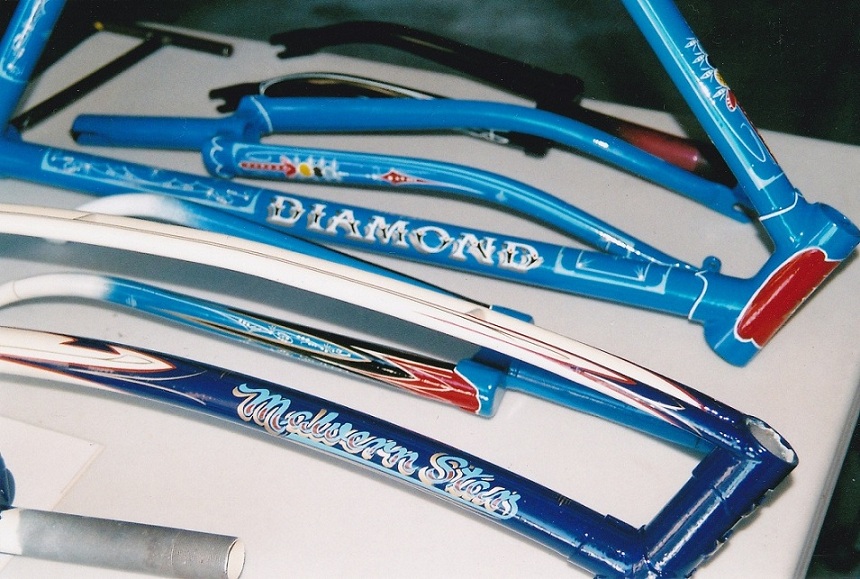
Peaks, names and linework - hand done by Kenn Dickie.
Photograph by Kenn Dickie.
| At the end of 1958 he finished his time. His indenture papers record he was a first class sprayer, liner, writer and scroller. General Accessories continued to employ him for his high quality work for the next 5 years, during which time the company was taken over by the Sir Arthur Warner’s Radio Corporation, and Bruce Small – its founder – left. But in this time transfers were being increasingly used. The craft of linework – a high cost item in production – replaced.
In 1963 he took a full time job as a storeman with Camden Art Supplies. Again quickly he moved through the firm and for the next 35 years was to represent several firms throughout New South Wales and Victoria selling art materials and framing supplies.
Before finishing at General Accessories however, Kenn had been approached by Rupe Bates in Coburg who then made the frames for Keep Bros. & Wood and Motor Spares to line their frames. He continued with this work when he joined Camden and what had begun as a part time job, became a regular fixture, and for the next 30 years – as well as his full time job with Camden – he worked for Rupe Bates and later his son Norm – four hours each Tuesday and Thursday evenings and all day Saturday.
The Bates name had become well respected in the trade from the 1920’s. Rupe built and repaired frames. From 1960 Kenn [amongst others] did the paint work. Special racing frames were contracted and his work involved personalised line work, scrolling, hand written names and small signs. He did restoration work on antique and special racers. Some… [are held in the collections of] the Hall of Fame (now National Sports Museum) at the Melbourne Cricket Ground and in Melbourne Museum’s collection (now Museum Victoria) at Spotswood.*
Kenn’s work with Bates [Cycles] finished in 1989 when the business… [was wound down]. Since then he has taken on “one-off” jobs for people who know of him.
I first met Kenn in 2002 after the funeral of Norm Bates. I had become interested in Australian bike decoration, some of which was localised. Folk in different localities talked of local liners who had built up reputations. I believe bike decoration to be a rich field for description. The bicycle is a beautiful item of design – appropriate decoration reinforces this beauty. I think there is a future in its re-emergence.20 – Rod Charles
*Items actually on display at these museums may vary. Please check with each museum before you visit.
Reproduced in part - with permission of Rod Charles and the convenors of the Australasian Cycling History Conference.
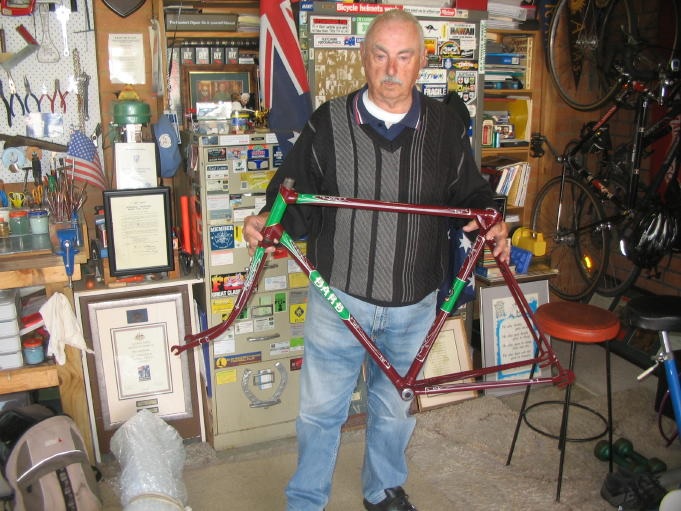
Kenn Dickie in his workshop. |
References:
1. “Athletic sports on the Melbourne Cricket Ground”, The Argus (Melbourne, Vic.: 1848-1956), July 12, 1869, 6. http://nla.gov.au/nla.news-article5821039
2. Greg Hunter (MCC), personal communication, February 8, 2013.
3. The Argus (Melbourne, Vic: 1848-1956), October 2, 1905, 6.http://nla.gov.au/nla.news-article10042514
4. Chronicling America: Historic American Newspapers - Library of Congress, The Salt Lake Tribune. (Salt Lake City, Utah), June 18, 1913, 8 http://chroniclingamerica.loc.gov/lccn/sn83045396/1913-06-18/ed-1/seq-8/
5. Jack Hephner and John Drummond, Goulburn to Sydney – a narrative of ninety years of a cycling classic 1902-1992 (Queenstown Tasmania: Penghana Press, 2007), 82.
6. The Argus (Melbourne, Vic: 1848-1956), March 26, 1941, 12. http://nla.gov.au/nla.news-article8168220
7. The Argus (Melbourne, Vic: 1848-1956), December 7, 1936, 7. http://nla.gov.au/nla.news-article11944573
8. The Argus (Melbourne, Vic: 1848-1956), February 15, 1938, 18. http://nla.gov.au/nla.news-article11148764
9. Greg Hunter (MCC), personal communication, May 22, 2013.
10. Andrew Rule, “’Rupe’ recalls the rides of his life”, Weekend Herald (Melbourne, Vic), November 16-17, 1985, 44.
11. Jo-Ann Bates, personal communication, June 17, 2013.
12. Ibid.
13. See note 10 above.
14. See note 10 above.
15. Kenn Dickie, personal communication, February 24, 2013.
16. See note 15 above.
17. See note 15 above.
18. Rod Charles, Kenn Dickie – Bicycle frame decorator: An introduction, 2005 Australasian Cycling History Conference – introductory speech.
19. See note 11 above.
20. See note 18 above. |